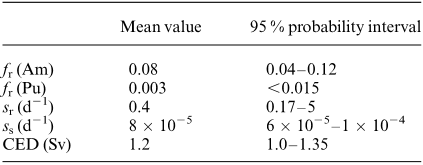




Did you find this useful? Give us your feedback













47 citations
...(598) Zalikin (1966a) followed the tissue distribution of (233)Pa for 128 d after administration of protactinium citrate (pH 3) to rats by intratracheal instillation....
[...]
29 citations
20 citations
...Furthermore, the 30-year follow-up of a plutonium-americium inhalation exposure, with a committed effective dose of the order of 100 cSv, shows no evidence of lung cancer; the subject is in good health (Wernli et al. 2015)....
[...]
17 citations
1 citations
75 citations
...As in the previous analysis, an effective AMAD(10) (Activity Median Aerodynamic Diameter) of 5 mm has been estimated from early lung and early faecal excretion data (including the activity that would have appeared in the faeces if it had not been not removed with a nasal swab and a bronchial slime before the first chest measurement was done(1))....
[...]
..., or based on the default values given in the IDEAS guidelines((10))....
[...]
...As in the previous analysis, an effective AMAD((10)) (Activity Median Aerodynamic Diameter) of 5 mm has been estimated from early lung and early faecal excretion data (including the activity that would have appeared in the faeces if it had not been not removed with a nasal swab and a bronchial slime before the first chest measurement was done((1)))....
[...]
...3 (7) 2 (7) 3 (10) Bone surface 10 (8) 9 (8) 14 (12)...
[...]
69 citations
67 citations
36 citations
...For Permissions, please email: journals.permissions@oup.com Radiation Protection Dosimetry (2014), pp. 1–8 doi:10.1093/rpd/ncu342 Radiation Protection Dosimetry Advance Access published December 19, 2014 at C olum bia U niversity L ibraries on M arch 1, 2015 http://rpd.oxfordjournals.org/ D ow nloaded from by simulating with MCNPX the counting efficiency for photons originated in the lungs and reaching the detectors around the skull....
[...]
...In addition to all the physical measurements, current cytogenetic analyses were performed at Federal Office for Radiation Protection((3)) to complete scientific data by biological studies....
[...]
...In addition to all the physical measurements, current cytogenetic analyses were performed at Federal Office for Radiation Protection(3) to complete scientific data by biological studies....
[...]
...242 data, including skeleton (3) and liver (3) data....
[...]
...Y FOLLOW-UP OF A PU/AM INHALATION CASE Christian Wernli1,*, Jost Eikenberg1, Olaf Marzocchi2, Bastian Breustedt2, Ursula Oestreicher3, Horst Romm3, Demetrio Gregoratto4 and James Marsh4 1Paul Scherrer Institute (PSI), Villigen, Switzerland 2Karlsruhe Institute for Technology (KIT), Karlsruhe, Germany 3Federal Office for Radiation Protection (BfS), Oberschleissheim, Germany 4Public Health England (PHE), Harwell Science and Innovation Campus, UK *Corresponding author: christian.wernli@alumni.ethz.ch In 1983, a young man inhaled accidentally a large amount of plutonium and americium....
[...]
34 citations